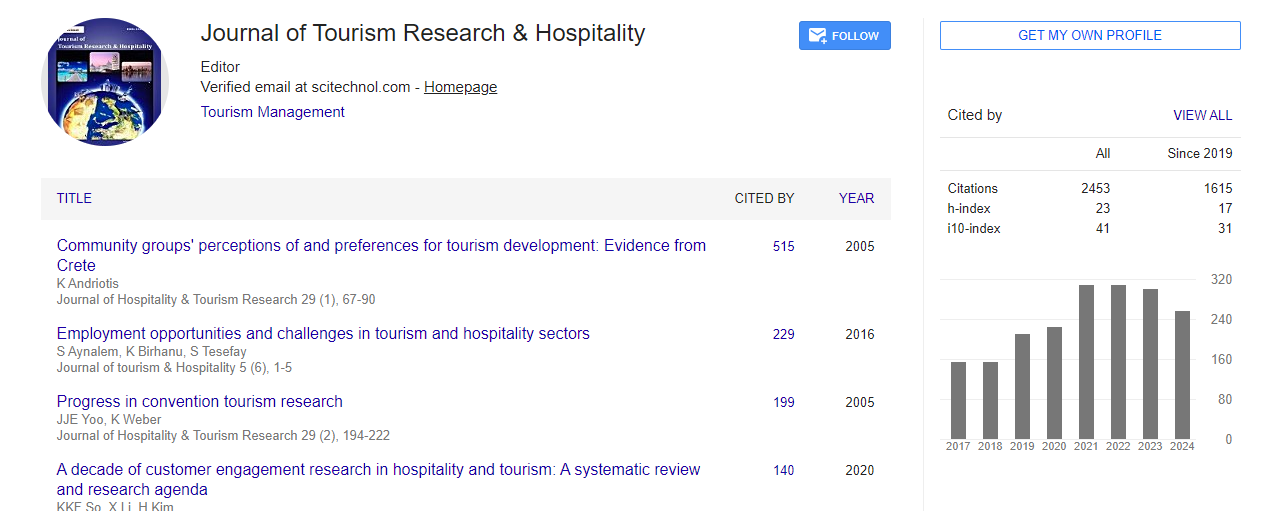Short Communication, J Tourism Res Hospitality Vol: 13 Issue: 6
Developing Sustainable Planning and Policies for Tourism
Luca Rossi*
1Department of Economics and Management, Bocconi University, Milan, Italy
*Corresponding Author: Luca Rossi,
Department of Economics and Management,
Bocconi University, Milan, Italy
E-mail: rossil36@gmail.com
Received date: 26 November, 2024, Manuscript No. JTRH-24-156539;
Editor assigned date: 28 November, 2024, PreQC No. JTRH-24-156539 (PQ);
Reviewed date: 12 December, 2024, QC No. JTRH-24-156539;
Revised date: 20 December, 2024, Manuscript No. JTRH-24-156539 (R);
Published date: 27 December, 2024, DOI: 10.4172/2324-8807.1000210.
Citation: Rossi L (2024) Developing Sustainable Planning and Policies for Tourism. J Tourism Res Hospitality 13:6.
Description
Tourism policy and planning are precarious components in shaping the tourism industry’s sustainable growth and development. As the tourism sector evolves, policymakers face increasing pressure to balance economic benefits with environmental conservation and cultural preservation. Effective tourism policies are not merely about attracting visitors but also about creating a framework that ensures a positive impact on local communities, ecosystems and economies. This intricate balance requires collaboration among stakeholders, including government agencies, private enterprises, local people and tourists themselves [1].
One of the fundamental aspects of tourism policy is its role in setting long-term goals. These goals should align with broader national or regional development plans. For instance, countries seeking to boost their GDP through tourism might prioritize investments in infrastructure, such as airports, roads and public utilities, while simultaneously promoting lesser-known destinations to distribute the influx of tourists more evenly. On the other hand, nations with fragile ecosystems may craft policies that limit the number of visitors or encourage eco-friendly practices. This strategic alignment ensures that tourism contributes meaningfully to overarching socioeconomic objectives while preserving natural and cultural resources [2].
Planning, on the other hand, translates these policies into actionable steps. It involves creating detailed strategies for land use, transportation, accommodation and visitor management. A welldesigned tourism plan addresses potential challenges, such as overcrowding, resource depletion and cultural degradation. For example, implementing zoning regulations can help prevent overdevelopment in sensitive areas, while establishing carrying capacity limits for popular attractions can reduce environmental strain. Additionally, digital tools like geospatial mapping and big data analytics have become invaluable in planning efforts, enabling authorities to predict trends and allocate resources effectively [3].
Stakeholder engagement is a foundation of successful tourism policy and planning. Local communities, in particular, play a vital role as custodians of cultural heritage and natural landscapes. Their involvement ensures that tourism initiatives reflect their needs and aspirations, promoting a sense of ownership and reducing potential conflicts. Similarly, collaboration with private sector entities can drive innovation and investment, while partnerships with Non-Governmental Organizations (NGOs) can provide expertise in sustainability and community development. By cultivating a participatory approach, policymakers can build consensus and gain public support for their strategies [4-6].
Sustainability remains a central theme in contemporary tourism policy and planning. The global shift toward sustainable tourism is driven by growing awareness of climate change, biodiversity loss and social inequalities. Policies that promote renewable energy use, waste reduction and responsible tourism practices are essential for mitigating tourism’s environmental footprint. For instance, encouraging ecotourism and green certifications for hotels can attract environmentally conscious travelers while supporting local economies. Furthermore, integrating climate flexibility into tourism planning ensures that destinations can adapt to changing weather patterns and other climaterelated challenges [7,8].
Crisis management is another precarious element of tourism policy and planning. The COVID-19 pandemic highlighted the vulnerabilities of the tourism sector, prompting governments to reassess their strategies. Policies must now incorporate contingency plans to address potential crises, whether they stem from public health emergencies, natural disasters, or geopolitical tensions. Flexible and adaptive planning enables destinations to recover swiftly and build long-term flexibility. For example, diversifying tourism products and markets can reduce dependency on specific visitor segments, ensuring stability during downturns [9].
Monitoring and evaluation are essential for assessing the effectiveness of tourism policies and plans. Regular data collection and analysis allow policymakers to identify areas for improvement and adapt their strategies accordingly. Key Performance Indicators (KPIs), such as visitor satisfaction, economic impact and environmental quality, provide valuable insights into the success of tourism initiatives. Moreover, transparency in reporting promotes accountability and trust among stakeholders, reinforcing their commitment to shared goals [10].
In conclusion, crafting effective tourism policies and planning strategies requires a comprehensive and forward-thinking approach. By integrating sustainability, stakeholder collaboration, crisis preparedness and rigorous evaluation, destinations can achieve a balanced and thriving tourism sector. As tourism continues to shape economies and cultures worldwide, well-designed policies and plans will be instrumental in ensuring its long-term benefits for all.
References
1. Butler RW (1980) The concept of a tourist area cycle of evolution: Implications for management of resources. Can Geogr 24(1): 5-12.
2. Sharpley R (2000) Tourism and sustainable development: Exploring the theoretical divide. J Sustain Tour 8(1): 1-19.
3. Bramwell B, Lane B (1993) Sustainable tourism: An evolving global approach. J Sustain Tour 1(1): 1-5.
4. Saarinen J (2006) Traditions of sustainability in tourism studies. Ann Tour Res 33(4): 1121-1140.
5. Hunter C (1997) Sustainable tourism as an adaptive paradigm. Ann Tour Res 24(4): 850-867.
6. Simpson MC (2008) Community benefit tourism initiatives-A conceptual oxymoron? Tour Manag 29(1): 1-18.
7.Jamal TB, Getz D (1995) Collaboration theory and community tourism planning. Ann Tour Res 22(1): 186-204.
8. Lane B (1994) What is rural tourism? J Sustain Tour 2(1-2): 7-21.
9. Mowforth M, Munt I (1998) Tourism and sustainability: Development and new tourism in the Third World. J Sustain Dev 6(3): 33-47.
10. Pearce DG (1989)Tourist development. J Sustain Tour 4(2): 63.
 Spanish
Spanish  Chinese
Chinese  Russian
Russian  German
German  French
French  Japanese
Japanese  Portuguese
Portuguese  Hindi
Hindi 

